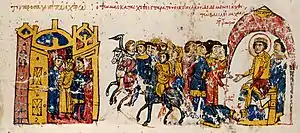823
Year 823 (DCCCXXIII) was a common year starting on Thursday (link will display the full calendar) of the Julian calendar.
| Millennium: | 1st millennium |
|---|---|
| Centuries: | |
| Decades: | |
| Years: |
| 823 by topic |
|---|
| Leaders |
|
| Categories |
|
| Gregorian calendar | 823 DCCCXXIII |
| Ab urbe condita | 1576 |
| Armenian calendar | 272 ԹՎ ՄՀԲ |
| Assyrian calendar | 5573 |
| Balinese saka calendar | 744–745 |
| Bengali calendar | 230 |
| Berber calendar | 1773 |
| Buddhist calendar | 1367 |
| Burmese calendar | 185 |
| Byzantine calendar | 6331–6332 |
| Chinese calendar | 壬寅年 (Water Tiger) 3519 or 3459 — to — 癸卯年 (Water Rabbit) 3520 or 3460 |
| Coptic calendar | 539–540 |
| Discordian calendar | 1989 |
| Ethiopian calendar | 815–816 |
| Hebrew calendar | 4583–4584 |
| Hindu calendars | |
| - Vikram Samvat | 879–880 |
| - Shaka Samvat | 744–745 |
| - Kali Yuga | 3923–3924 |
| Holocene calendar | 10823 |
| Iranian calendar | 201–202 |
| Islamic calendar | 207–208 |
| Japanese calendar | Kōnin 14 (弘仁14年) |
| Javanese calendar | 719–720 |
| Julian calendar | 823 DCCCXXIII |
| Korean calendar | 3156 |
| Minguo calendar | 1089 before ROC 民前1089年 |
| Nanakshahi calendar | −645 |
| Seleucid era | 1134/1135 AG |
| Thai solar calendar | 1365–1366 |
| Tibetan calendar | 阳水虎年 (male Water-Tiger) 949 or 568 or −204 — to — 阴水兔年 (female Water-Rabbit) 950 or 569 or −203 |

Thomas the Slav surrenders to Michael II
Events
Byzantine Empire
- Emperor Michael II defeats the rebel forces under Thomas the Slav in Thrace. He and his supporters are forced to seek refuge in Arkadiopolis (modern Turkey). After five months of blockade, Thomas surrenders and is delivered to Michael, seated on a donkey and bound in chains. He pleads for clemency and prostrates before Michael, but is executed.[1][2]
Europe
- April 5 – Lothair I, eldest son of Emperor Louis I, is crowned co-emperor again by Pope Paschal I at Rome (initiating the papal practice of handing the imperial sword over, as a symbol of temporal power in the Holy Roman Empire).
Britain
Japan
- May 30 – Emperor Saga abdicates the throne, after a 10-year reign. He is succeeded by his brother Junna, as the 53rd emperor of Japan.
Births
Deaths
- Adelochus, archbishop of Strasbourg (b. 786)
- Boniface I, margrave of Tuscany
- Ceolwulf I, king of Mercia (approximate date)
- Gondulphus, bishop of Metz
- Han Hong, general of the Tang Dynasty b. 765)
- Ljudevit, duke of the Slavs in Lower Pannonia
- Thekla, Byzantine empress (approximate date)
- Thomas the Slav, Byzantine general and usurper
- Timothy I, Syrian patriarch
- Wulfheard, bishop of Hereford (approximate date)
References
- Bury, John Bagnell (1912). A History of the Eastern Roman Empire from the Fall of Irene to the Accession of Basil I (A.D. 802–867). London: Macmillan and Company. pp. 105–106. OCLC 458995052.
- Treadgold, Warren (1988). The Byzantine Revival, 780–842. Stanford, California: Stanford University Press. pp. 241–242. ISBN 978-0-8047-1462-4.
- "Charles II | Holy Roman emperor". Encyclopedia Britannica. Retrieved November 27, 2020.
This article is issued from Wikipedia. The text is licensed under Creative Commons - Attribution - Sharealike. Additional terms may apply for the media files.